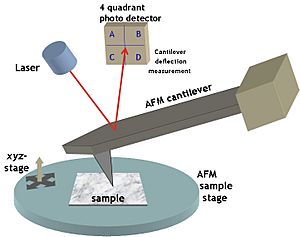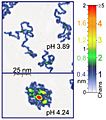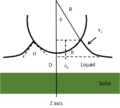Atomic force microscope facts for kids
Atomic force microscopes (AFMs) are a type of microscope. AFMs provide pictures of atoms on or in surfaces. Like the Scanning Electron Microscope (SEM), the purpose of the AFM is to look at objects on the atomic level. In fact, the AFM may be used to look at individual atoms. It is commonly used in Nanotechnology.
The AFM can do some things that the SEM cannot do. The AFM can sometimes provide higher resolution than the SEM. Further, the AFM does not need to operate in a vacuum. In fact, the AFM can operate in ambient air or water, so it can be used to see surfaces of biological samples like living cells.
The AFM works by employing an ultra-fine needle attached to a cantilever beam. The tip of the needle runs over the ridges and valleys in the material being imaged, "feeling" the surface. As the tip moves up and down due to the surface, the cantilever deflects. In one basic configuration, a laser shines on the cantilever at an oblique angle, and allows for the direct measurement of the deflection in the cantilever by simply changing the angle of incidence for the laser beam. In this way, an image may be created revealing the configuration of the molecules being imaged by the machine.
There are many different operating modes for an AFM. One is the "contact mode", where the tip is simply moved across the surface and the cantilever deflections are measured. Another mode is called "tapping mode", because the tip is tapped against the surface as it travels along. By controlling how hard the tip is tapped, the AFM can move away from the surface when the needle feels a ridge, so that it will not hit against the surface when it moves across. This mode is also useful for biological samples, because it is less likely to damage a soft surface. These are the basic modes most commonly used, however there are different names and methods such as "intermittent contact mode", "non-contact mode", "dynamic" and "static" modes and more, but are often variations on the above described tapping and contact modes.
Related pages
Images for kids
-
AFM image of part of a Golgi apparatus isolated from HeLa cells
See also
 In Spanish: Microscopio de fuerza atómica para niños
In Spanish: Microscopio de fuerza atómica para niños









